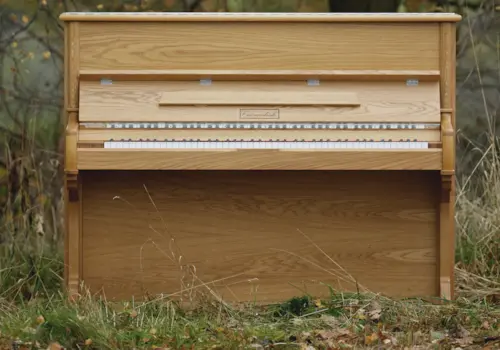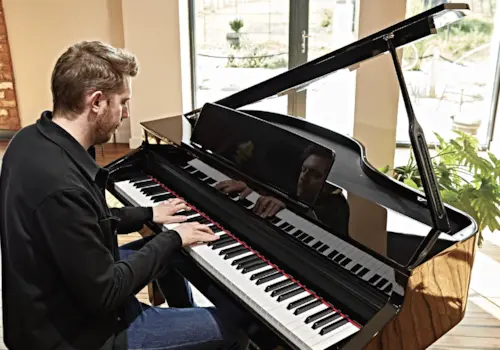Here are Pianist's 5 alternative methods of playing the piano...but not necessarily the keys.
Originality is something that everybody strives for but can struggle to find.
Question: How do we prevent our ourselves from sounding like everybody else, especially when it comes to composition and arrangement?
Answer: You think bigger.
Take a minute to think of something drastic that you could change about the piece. Think about playing a Beethoven piece using synth sounds rather than a grand piano. Think about completely re-scoring a piece by playing it back to front. Think about not playing the piano keys at all (what?!).
Not playing the piano keys? You see, it sounds a little crazy! Why not try it? It’ll guarantee your originality, that’s for certain. Let’s take a look at some of these unconventional ways of playing the piano that can be incorporated into your own arranging and composing.
1. Pluck the strings
Also known as the ‘string piano technique’, this technique can be used on an upright or grand. It’s simple: Open up the body of your piano to expose the strings. Pluck the strings with your fingertips, as if you were playing the harp. The harder you pluck them, the more the treble frequencies will resonate. Plucking with the sustain pedal down will create a beautiful legato sound. Play without the pedal and you’ll create a pizzicato-type sound.
2. Use the strings to play a glissando
This can be done using almost any object you like! You may want to simply stick to using your fingernails. Think about what else you could use to create a different timbre. Try a guitar pick, a knitting needle, a stick, or even a rubber. Take your chosen object and rub it up the strings. Try playing with the sustain pedal down for a varied sound.
3. Create percussive sounds
Give your piece some punch! Here are parts of the piano we recommend you play percussively:
- The top rim of your fallboard
- The sidearm
- The top board
- The rim of the body
Try out a selection of different rhythms using your hands. Once you are comfortable with this, try incorporating some piano playing in between.
Additionally, try tapping the fallboard against the body of the piano that lies behind it. Watch this video below of jazz pianist and singer Jamie Cullum doing just that.
4. Palm Muting
Time to get rid of your piano stool! You’ll definitely need to stand up for this technique. Make sure you take a strong stance in order to keep your back supported.
Lean over into your piano, take the palm of your hand, and place it over a portion of the strings. With your other hand, play the piano. This technique can create a brilliant staccato bass-like sound. Alternatively, make your stance even more complex by playing the sustain pedal at the same time. The use of the pedal here will create a more eerie, legato sound.
TIP: If you are struggling with this particular stance, try placing an object onto the strings in place of your hand. Something heavy, for example, a book, should do the trick.
5. Create sympathetic vibrations
First of all, what are sympathetic vibrations?
Sympathetic vibrations occur when strings that are not being played respond to the vibrations of a string that IS being played, causing those unplayed strings to resonate. Certain strings are ‘sympathetic’ to the vibrations of the played string because they have very similar levels of frequency.
Let’s take the note C as an example. One note that is very ‘sympathetic’ to this note is the C in the octave above. When we gently depress and hold the higher C, the hammers do not produce any sound. Instead, the hammers are released from the strings. This makes them capable of vibrating sympathetically with other notes. Let’s try it out:
- Gently hold down the higher C without it making any sound. Keep your finger pressed down.
- With your left hand, strike the lower C note, mezzo forte or above, in a staccato fashion.
- Listen carefully and you will hear the frequencies of that higher C note begin to ring out!
The third and fifths of C are much less receptive to this technique. However, it’s definitely worth spending some time experimenting.
TIP: When arranging your own version of an existing piece of music, try creating sympathetic vibrations after a loud staccato note or chord has been played, for example, at the end of a variation. It’ll delightfully surprise the listener!
How do I notate these techniques in my score?
You’ll find it hard to research score notations for these techniques as they are very original (which is what we want!). So, here are some of Pianist’s quick tips on how you can notate these techniques on your score in the clearest way possible.
- Non-pitched techniques: Create a new stave on your score. Mark it using the percussion clef - which you can see below underneath the bass clef. As they are non-pitched, keep all your notes on one line. Make sure to name your percussion clef according to which part of the piano you are playing.
- Use of the piano strings: Make a further separate clef. As these notes are pitched, use treble or bass clef accordingly. Insert the notes you are playing as normal. If you are plucking the notes, mark them as pizzicato. If you are playing glissandos on the strings, mark the notes accordingly. If you are using external objects to play the strings, simply mark the notes with the name of the object. Again, make sure to name your clef in order to differentiate it from your other clefs.
- Palm muting: Insert the marking ‘muted’ into your music where appropriate. Simple!
- Sympathetic vibrations: Mark your silent note or chord as sustained, and as pppppppp. Hungarian-Austrian composer György Ligeti utilises this extreme dynamic in his compositions.
You can find all the symbols you need here.







